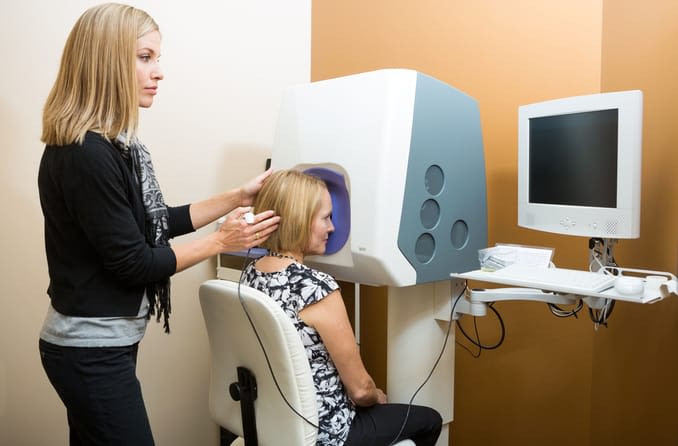Retinal imaging and scans

Optometrists and ophthalmologists have several forms of retinal imaging at their disposal. Each plays a slightly different role in maintaining the health of your retina — the thin layer of tissue in the back of your eye that is essential for good vision.
What can a retinal screening detect?
Some forms of retinal exams are better at detecting certain diseases than others. Your eye doctor will decide which test(s) to perform depending on any risk factors and/or symptoms you may have.
In addition to monitoring the overall health of your eyes, a retinal exam can be used to detect the early signs of some conditions, including:
Diabetic retinopathy (a complication of diabetes)
Hypertensive retinopathy (a complication of high blood pressure)
Digital retinal imaging during an eye exam
If you’ve had an eye exam recently, there’s a good chance you’ve seen a digital retinal scan machine. This quick and affordable form of retinal screening has become a staple in eye doctors’ offices across the United States.
These retinal imaging devices use special technology to photograph an ultra-wide view of the inside of your eye in a single image. Included in the image is a detailed view of the retina, optic nerve and retinal blood vessels, all of which can show signs of underlying eye conditions. The process is quick and painless, and doesn’t have any side effects.
While dilation is the best way for the doctor to see the whole retina and get an accurate view of the optic nerve, digital retinal imaging can be a very useful additional test.
Some eye care professionals bundle digital retinal imaging into the overall fee for a comprehensive eye exam, but it’s more likely to be billed separately. In our nationwide eye exam cost survey, we found that eye doctors charged an average range of $25 to $50 for a digital retinal test.
Retinal imaging tests and devices
There are many ways an eye doctor can examine your retinas — and take their photos. These imaging tests and devices may include:
Optomap
One of the most common retinal screening devices is Optos’ optomap, which offers a 200-degree view of the retina. This type of digital imaging can be used for the everyday patient — it’s often offered with a comprehensive eye exam.
Other retinal tests are more specialized for diagnosing and monitoring specific eye conditions. They are usually performed by an ophthalmologist, or more specifically, a retinal specialist.
Optical coherence tomography
Also called OCT, optical coherence tomography is an imaging technique that uses light waves to take cross-sectional images of the retina. These images are then used to create a 3D map of the retina’s layers and measure their varying levels of thickness. OCT can also help detect changes in the optic nerve.
Eye doctors may use OCT to detect, diagnose and/or monitor numerous conditions, including:
Problems with the macula
Glaucoma
Age-related macular degeneration
Ocular ultrasound
Ultrasounds use “silent” sound waves to get a real-time view of the inside of your eye. They can be particularly useful when there is bleeding inside the eye, which can make it difficult for an eye doctor to spot the signs of retinal detachment, retinal tears or other retinal conditions.
Two different scans — an “A-scan” and “B-scan” — can be used to get different information about the retina and other tissues inside the eye.
Fundus photographs
Fundus photos are similar to digital retinal images, but they usually require pupil dilation beforehand. They also capture a smaller amount of surface area inside the eye. The images captured by fundus cameras are usually used to compare the progression of an eye disorder over time.
Fluorescein angiography
Fluorescein angiography is a test that involves injecting dye into the bloodstream and then taking pictures of the inner eye. It is usually used to monitor the retinal effects of diabetes, hypertension or macular degeneration.
Be careful not to confuse a fluorescein angiography with a fluorescein stain test, which is a way of detecting a scratched cornea or other issues on the front surface of the eye.
Schedule an appointment with your eye doctor
Having an eye doctor regularly examine your retinas, either with a digital imaging device or during a comprehensive eye exam with pupil dilation, ensures any retinal conditions are diagnosed and treated as early as possible.
Contact your eye doctor for more information about which retinal screening options are available for you.
Wide field retinal imaging systems. EyeWiki. American Academy of Ophthalmology. February 2024.
Ultra-widefield imaging adding depth to pediatric ophthalmology. Ophthalmology Times. May 2020.
Ultra-wide field retinal imaging: A wider clinical perspective. Indian Journal of Ophthalmology. April 2021.
Retinal imaging. Cleveland Clinic. June 2023.
What is optical coherence tomography? EyeSmart. American Academy of Ophthalmology. April 2023.
Advanced retinal imaging. The Foundation of the American Society of Retina Specialists. Accessed April 2024.
Page published on Tuesday, October 20, 2020
Page updated on Tuesday, April 23, 2024
Medically reviewed on Wednesday, April 10, 2024






